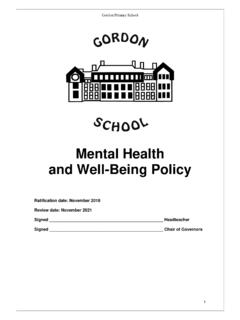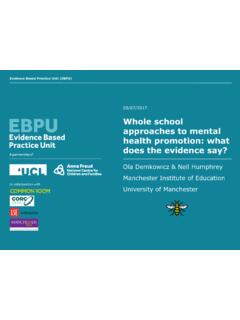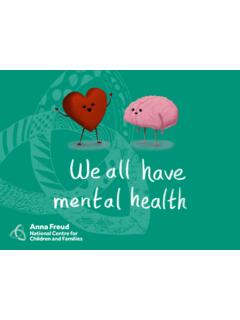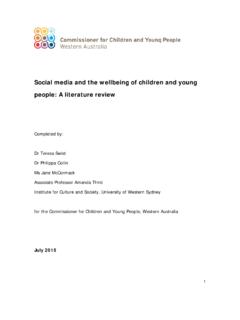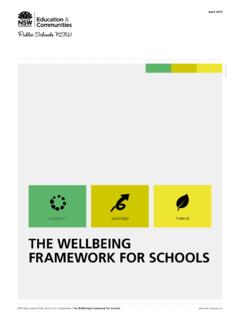Transcription of Measuring and monitoring children and young people’s ...
1 Measuring and monitoring children and young people 's mental wellbeing : A toolkit for schools and colleges Foreword With half of all diagnosable mental health disorders established The toolkit aims to raise awareness amongst school and by the age of 14, there is a strong case to promote children college staff of the range of validated tools that are available and young people 's mental health. to help measure subjective mental wellbeing amongst the student population. This, in turn, will help school and college There are a range of risk and protective factors that impact on leaders make use of school and college level data to identify mental wellbeing .
2 These span individual factors, family, learning the mental wellbeing needs of students and determine how environments and the wider community. The evidence tells us best to address these. Efforts taken by schools and colleges that the learning environment plays an important and valued to promote the physical and mental health of the student role in helping protect and promote student mental wellbeing . population creates a virtuous circle, reinforcing attainment and achievement that in turn improves student wellbeing , Public Health England and the Anna Freud National Centre enabling students to thrive and achieve their full potential.
3 For children and Families are committed to improving health outcomes for children , young people and their families, and collaborated to fund and develop this toolkit. Eustace de Sousa Dr Jessica Deighton National Lead children , young people and Families, Public Health England Lecturer in School-Based Mental Health Research, Evaluation, and Evidence- Based Research UCL and Deputy Director of the Evidence Based Practice Unit, UCL and the Anna Freud National Centre for children and Families Measuring and monitoring children and young people 's mental wellbeing : A toolkit for schools and colleges 2.
4 Contents Introduction 1 4. Section 1: What do we mean by mental wellbeing and how and why measure it in schools and colleges ? 1. What do we mean by mental wellbeing ? 6. How can schools and colleges influence mental wellbeing ? 7. Why measure? Taking a snapshot 9. Why measure? Identification 11. Why measure? Evaluation 13. Section 2: Practice examples 25. Section 3: Introducing wellbeing instruments to students 36. Section 4: Compendium of positive mental health and wellbeing instruments 43. Further resources and signposting 80. Glossary 88. Appendix: How the content of this toolkit was developed 89.
5 Measuring and monitoring children and young people 's mental wellbeing : A toolkit for schools and colleges 3. Introduction Schools and colleges are a vital part of children What does it aim to achieve? The aim of this toolkit is and young people 's support system and are to make schools and college staff aware of the range of increasingly recognised as key sites to help validated instruments that can be used to measure and promote mental wellbeing . The Department for monitor student mental wellbeing . Education offers specific guidance on mental health and counselling in schools. In addition, Scope: The instruments that are signposted to focus Personal Development, Behaviour and Welfare on subjective measures of positive wellbeing and can be complemented by other objective measures collected is a key judgement area within the Ofsted routinely in schools and colleges such as the extent of inspection framework.
6 As such, school and student participation or rates of bullying and behaviour college leadership teams have a strong rationale and attendance. Collectively this kind of data will help to for assessing the health and wellbeing needs of build a wider picture of the mental wellbeing of the student their population and taking proportionate action population. to address their needs. Whilst the general content of the toolkit will be of relevance to schools and colleges, the compendium of tools have been Who is this toolkit for? The toolkit will be of interest to senior categorised according to their application across key stages leadership teams and those with particular responsibilities for 1 to 5, therefore the upper age range covers 16-18 year olds.
7 Special Educational Needs and Disabilities (SEND), inclusion, Whilst we sought to include practice examples from across Personal Social Health and Economic education (PSHE), the primary, secondary, special and college sectors, we welfare or pastoral support and mental health support. It will limited the focus in this toolkit to those examples where also be of interest to partners from the health, voluntary and validated tools had been used in practice. community service sector who are supporting schools and We have used the term students' as an inclusive term colleges to improve mental health outcomes for children , young covering primary school age pupils as well as secondary and people and their families.
8 College students. Measuring and monitoring children and young people 's mental wellbeing : A toolkit for schools and colleges Back to contents page 4. Overview Overview of content of the toolkit Section one explores what do we mean by mental wellbeing , sets out 3 core purposes for why schools and colleges might measure student mental wellbeing and 7 steps to implementation. Section two sets out some practice examples from a range of schools and colleges that have applied such tools to practice and have helpfully shared their learning. Section three offers practical advice for introducing wellbeing instruments to students Section four provides a compendium of validated instruments that can be used to measure students' subjective mental wellbeing The toolkit also signposts to further resources and sources of support and includes a glossary of terms.
9 Further information on the process which informed the development of the toolkit can be found in the Appendix. Measuring and monitoring children and young people 's mental wellbeing : A toolkit for schools and colleges Back to contents page 5. Section 1: What do we mean by mental wellbeing ? What do we mean by mental wellbeing ? Mental wellbeing is not simply the absence of mental illness but is a broader indicator of social, emotional and physical INDIVIDUAL FAMILY. Physical health Parental physical &. wellness. As shown by Figure 1, it is influenced by the wider Social & emotional skills mental health contexts within which a child or young person lives.
10 Learning & Development Family relationships Financial hardship For schools and colleges, it is important to have a definition that is easily understandable so that staff, pupils, students and parents can have a shared understanding of what is meant by CHILD. mental wellbeing . For the purposes of this guide, we define mental wellbeing as children and young MENTAL. people 's happiness, life satisfaction and positive HEALTH &. functioning. young advisors described this as: wellbeing . children and young people feeling COMMUNITY LEARNING. good, feeling that their life is going Neighbourhood safety Neighbourhood poverty ENVIRONMENT.



